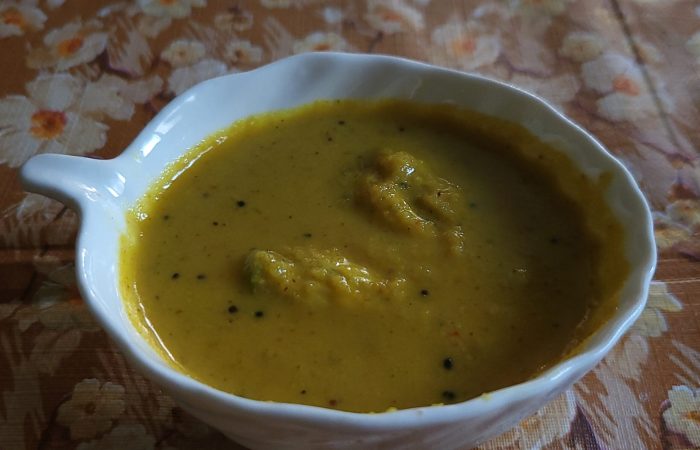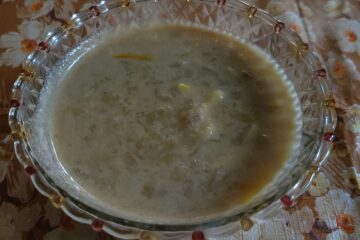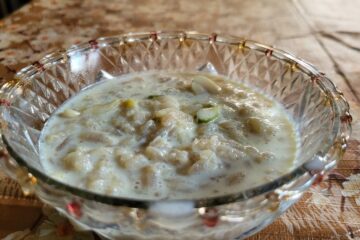In the coastal regions of Goa and Konkan, a sour fruit known as Ambade (Hog Plums) is found. In Goan cuisine, various dishes are prepared using this tangy fruit. You can often spot Ambade trees in the courtyards or backyards of Goan homes. The fruit begins to appear around the month of Shravan (July–August) and lasts until Diwali. During Shravan, the Ambade are tender and light green in colour, but by Diwali, they turn into a deep dark green as they mature and develop a hard seed inside. A special preparation called Ambadyachi Karam (Ambade relish) is made from these mature fruits, especially during Diwali. Alongside festive delicacies like Doodh Fov, Batat Fov, and Rosatle Fov, this tangy Ambadyachi Karam is also enjoyed with great relish during the celebrations.
Various dishes like Ambadyachi Uddamethi (Ambade with fenugreek) and Ambadyacho Ros (Ambade curry) are made using this fruit. But Ambade are especially used to enhance the flavour of Sungtache Hooman, the traditional Goan prawn curry, making it even more delicious.
Now, let’s see how to prepare Ambadyachi Karam, the special Ambade relish made during Diwali.
Ingredients for Making Ambadyachi Karam (Ambade Relish)
Ambade (Hog plums) – 7 to 8
Freshly grated coconut – 2 bowls
Grated or finely chopped jaggery – 1 bowl (adjust according to the sourness of the Ambade and your taste)
Dried red chillies – 4 to 5 (adjust depending on the spice level)
Coriander seeds – 1 tablespoon
Black peppercorns – 1 teaspoon
Turmeric powder – ½ teaspoon
Salt – to taste
Ingredients for the Tempering (Tadka)
Oil – 1 tablespoon (preferably coconut oil for authentic flavour)
Mustard seeds – 1 teaspoon
Asafoetida (Hing) – 2 pinches
Curry leaves – 10 to 12 leaves
Fenugreek seeds (Methi) – ½ teaspoon
Method
Pre-preparation
Wash the Ambade thoroughly and scrape off their outer skin.
Slice the scraped Ambade thinly using a knife.
Crush the remaining seed (kernel) well to extract its flavour.
Grind together the grated coconut, dried red chillies, coriander seeds, peppercorns, and turmeric powder in a mixer, adding just enough water to make a smooth paste.

Cooking Process
Place a pan on the stove and add the sliced Ambade along with the crushed seed (kernel). Add the water released while crushing the seed and a little extra water. Let it cook gently on a low flame for a few minutes.
Once the Ambade are partially cooked, add the freshly ground coconut masala and continue cooking for about 5 more minutes.
After five minutes, add the grated or chopped jaggery to the mixture and let it simmer until the jaggery completely dissolves.
When everything is well cooked and blended, add salt to taste and reduce the flame to low.
Tempering (Tadka)
On another burner, heat a small pan for tempering and add oil to it.
Once the oil is hot, add the mustard seeds.
When the mustard seeds start to splutter, add the curry leaves and stir well.
Finally, add the fenugreek seeds and asafoetida (hing), mix once, and turn off the flame.
Final Step
Add the prepared tempering to the simmering Ambadyachi Karam and turn off the flame.
Cover the pan with a lid and let it rest for a while — this allows the flavours to blend beautifully, giving the Ambadyachi Karam its rich, tangy taste.
Among the many festive delicacies prepared during Diwali, Ambadyachi Karam stands out for its delightful sweet-and-sour flavour. It’s a must-try dish, best enjoyed alongside other traditional Diwali preparations.
Note:
If you prefer not to use dried red chillies, you can replace them with 1 to 1½ teaspoons of red chilli powder, adjusting the quantity according to your taste.


